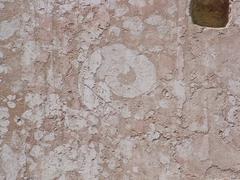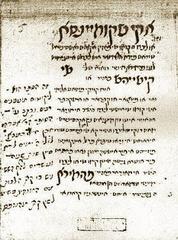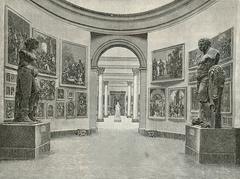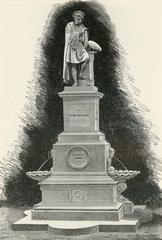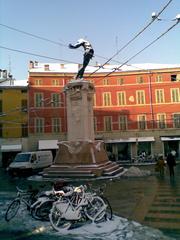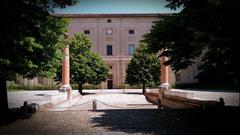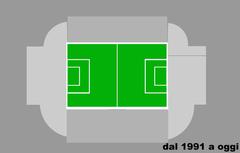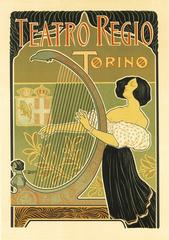Teatro Farnese Visiting Hours, Tickets, and Comprehensive Guide to Parma’s Historical Gem
Date: 14/06/2025
Introduction
Teatro Farnese, housed within the grand Palazzo della Pilotta in Parma, Italy, is a masterwork of early 17th-century theatre architecture and a testament to Baroque ingenuity. Commissioned by Duke Ranuccio I Farnese and designed by Giovan Battista Aleotti in 1618, the theatre is celebrated for pioneering the permanent proscenium arch—a concept that revolutionized European stage design. Despite severe wartime damage, Teatro Farnese has been meticulously restored and today stands as one of Parma’s most significant cultural attractions, offering visitors a unique window into the city’s opulent past and the evolution of theatre (Museionline; Istituto Italiano di Cultura di Sydney).
This guide details the theatre’s history, architectural significance, visitor information, travel tips, accessibility, and answers to frequently asked questions, providing everything you need for a rewarding visit to one of Italy’s most iconic historical sites.
Table of Contents
- Introduction
- Historical Overview and Construction
- Architectural Significance
- Cultural Impact and Restoration
- Visitor Information
- Practical Travel Tips
- Nearby Attractions
- Frequently Asked Questions (FAQ)
- Visuals and Interactive Elements
- Summary and Recommendations
- References
Historical Overview and Construction
Teatro Farnese was conceived in 1618 as a grand gesture to honor the anticipated visit of Cosimo II de’ Medici, though it would not be inaugurated until a decade later for the lavish wedding of Odoardo Farnese and Margherita de’ Medici. Architect Giovan Battista Aleotti drew inspiration from innovative predecessors like the Teatro Olimpico in Vicenza, but gave the Farnese a unique character through its extensive use of red spruce wood—painted and stuccoed to resemble marble—and its monumental horseshoe-shaped auditorium (Museionline; Wikipedia).
The theatre’s interior was richly adorned with plaster sculptures and paintings by leading artists of the time, including Luca Reti and Giovan Battista Trotti. Its design allowed for elaborate court spectacles, from operas to mock naval battles, thanks to advanced stage machinery and a floodable parterre (Theatre Architecture EU; Italy Magazine).
Architectural Significance
Teatro Farnese is globally recognized for introducing the permanent proscenium arch—a structural and visual innovation that would become the standard in theatres across Europe (Britannica). The theatre’s enormous scale (87 meters long, seating for up to 3,000–4,500 spectators) and its 14 tiers of seating reflect both the artistic ambition and the social hierarchy of the Farnese court (Museionline; The Crazy Tourist).
The stage, measuring 40 meters in length, was equipped with movable scenery and trapdoors, facilitating dramatic visual effects and rapid scene changes. The auditorium’s U-shaped configuration, adorned with serliana arches and statuary, creates a sense of grandeur and intimacy that continues to captivate visitors today (Italy Magazine).
Cultural Impact and Restoration
Despite its splendor, Teatro Farnese was used sparingly—reserved for the most significant dynastic and diplomatic events. Its 1628 inauguration set the standard for courtly entertainment in Italy, blending music, theatre, and spectacular stagecraft (Theatre Architecture EU). Today, it is considered one of the only three surviving Renaissance theatres in the world, alongside the Teatro Olimpico and Teatro all’Antica (Wikipedia).
The theatre suffered devastating damage during World War II, when Allied bombing caused a fire that destroyed much of its wooden structure. Restoration efforts from 1956 to 1960, using original plans and recovered materials, allowed the theatre to be faithfully reconstructed. Since its reopening in 1962, it has served as an entrance to the Galleria Nazionale di Parma and as a symbol of Parma’s resilience and enduring cultural heritage (Britannica; Museionline).
Visitor Information
Location and Access
Teatro Farnese is part of the Palazzo della Pilotta complex, centrally located at Piazzale della Pace, a short walk from Parma’s main train station (Our Escape Clause). The complex is easily accessible by foot or public transport, and parking is available nearby.
Visiting Hours (as of 2025)
- Tuesday to Saturday: 8:30 AM – 7:00 PM
- Sundays and Holidays: 1:00 PM – 7:00 PM
- Closed on Mondays
Note: Hours may vary for holidays or special events. Always check the official website before your visit.
Tickets and Admission
- Standard Ticket: €12 (combined ticket for all museums in Palazzo della Pilotta)
- Reduced Admission: €2
- Group Tickets: €10 per person
- Free Admission: First Sunday of each month
Tickets can be purchased onsite or online. The combined ticket gives access to the Teatro Farnese, Galleria Nazionale, Biblioteca Palatina, and National Archaeological Museum (Museionline; Lonely Planet).
Tours and Accessibility
- Guided Tours: Available for groups or by special arrangement; highly recommended for historical and architectural insights.
- Accessibility: Ramps and elevators provide access for visitors with limited mobility. Some upper galleries may be inaccessible due to the historic nature of the building; contact the venue in advance for specific needs.
- Audio Guides: Occasionally available for an extra fee; inquire at the ticket office.
Practical Travel Tips
- Arrive early to avoid crowds, especially on weekends and free-admission days.
- Check for temporary closures or exhibitions on the official website.
- Wear comfortable shoes as the complex is large and involves substantial walking.
- Photography is permitted without flash or tripods.
- Facilities: Restrooms and a bookshop are available on site. Cafés and restaurants are plentiful around Piazza della Pace (Itchy Feet Travel).
- Language: Signage is typically in Italian and English; staff generally speak basic English.
Nearby Attractions
- Palazzo della Pilotta Museums: Including Galleria Nazionale, Biblioteca Palatina, and National Archaeological Museum.
- Piazza della Pace: A lively green space adjacent to the complex.
- Parma Cathedral (Duomo) and Baptistery: Notable medieval monuments within walking distance.
- Teatro Regio: Parma’s renowned opera house.
- Historic Center: Enjoy Parma’s charming streets, markets, and local cuisine (Visit Italy; Our Escape Clause).
Frequently Asked Questions (FAQ)
Q: What are Teatro Farnese’s opening hours?
A: Tuesday to Saturday, 8:30 AM – 7:00 PM; Sundays and holidays, 1:00 PM – 7:00 PM; closed on Mondays.
Q: How do I buy Teatro Farnese tickets?
A: Tickets are available at the Palazzo della Pilotta ticket office or online. The ticket covers all museums in the complex.
Q: Is the theatre accessible for people with disabilities?
A: Yes, with ramps and elevators for most areas. Some upper galleries may be inaccessible.
Q: Are guided tours available?
A: Yes, especially for groups or by advance booking. Inquire at the ticket office or via the official website.
Q: Can I take photographs inside Teatro Farnese?
A: Non-flash photography is permitted; tripods are not allowed.
Q: Are events or performances held at Teatro Farnese?
A: Occasional concerts and cultural events are hosted—check the official calendar for details (Visit Italy).
Visuals and Interactive Elements
Alt text: Teatro Farnese proscenium arch and auditorium, interior view with wooden galleries.
Summary and Recommendations
Teatro Farnese is an architectural and cultural jewel that encapsulates the artistic ambitions of the Farnese dynasty and the evolution of European theatre. Its permanent proscenium arch, innovative stage machinery, and vast, restored wooden auditorium make it a must-visit for anyone interested in the intersection of history, architecture, and the performing arts. Visitors are encouraged to plan ahead: check the latest visiting hours, book combined tickets, and consider a guided tour to fully appreciate the theatre’s storied past and technical marvels.
For updates, virtual tours, and special events, visit the official Palazzo della Pilotta website, download the Audiala app for audio guides, and follow local cultural channels on social media.
References
- Museionline
- Wikipedia
- Theatre Architecture EU
- Britannica
- Istituto Italiano di Cultura di Sydney
- catisoutoftheoffice.com
- Italy Magazine
- Visit Italy
- Our Escape Clause
- Lonely Planet
- The Crazy Tourist
- Itchy Feet Travel
- Travel Science Musings
